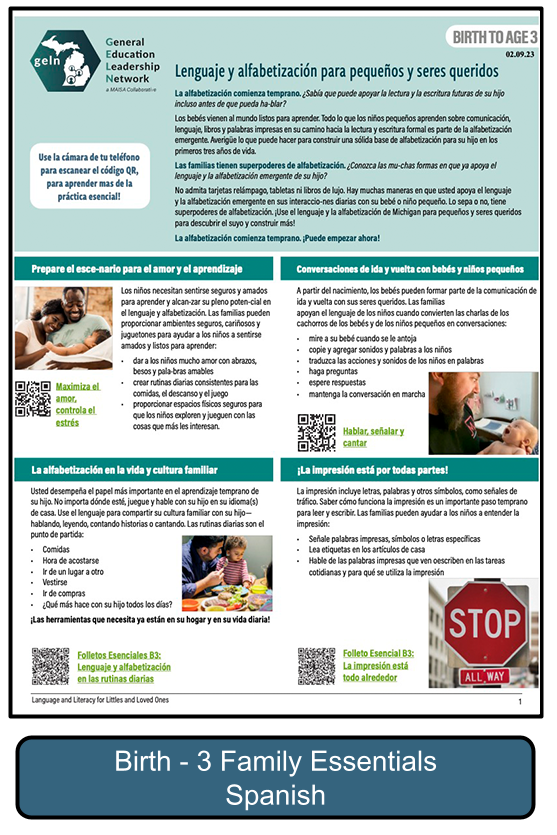Birth to Age 3
Essential Instructional Practices in Language and Emergent Literacy: Birth to Age 3
 This document aims to increase Michigan's capacity to improve children's literacy by identifying a small set of research-supported literacy practices that should be a focus of professional development throughout the state. The document focuses on practices in individual interactions with children rather than center- or systems-level practices. The document focuses on infants and toddlers, as the first 3 years of life are when children learn the fastest and acquire the foundational skills to support their development and learning for the rest of their lives. Improving language and literacy experiences in the infant and toddler years can potentially improve "reading by third grade" outcomes. Early childhood programs can also help to address disparities in literacy achievement.
This document aims to increase Michigan's capacity to improve children's literacy by identifying a small set of research-supported literacy practices that should be a focus of professional development throughout the state. The document focuses on practices in individual interactions with children rather than center- or systems-level practices. The document focuses on infants and toddlers, as the first 3 years of life are when children learn the fastest and acquire the foundational skills to support their development and learning for the rest of their lives. Improving language and literacy experiences in the infant and toddler years can potentially improve "reading by third grade" outcomes. Early childhood programs can also help to address disparities in literacy achievement.
This document is intended to be read in concert with the Essential Instructional Practices in Early and Elementary Literacy: Prekindergarten. Important overlap and continuity exist in these and other "Essentials" documents.
Family Materials - Language and Literacy for Littles and Loved Ones: Birth to Age 3
 Literacy starts early. Did you know you can support your child's future reading and writing before they can even talk?
Literacy starts early. Did you know you can support your child's future reading and writing before they can even talk?
Babies come into the world ready to learn. Everything young children learn about communication, language, books, and printed words on their way to formal reading and writing is part of emergent literacy. Find out how to build a strong literacy foundation for your child in the first three years of life.
Families have literacy superpowers. Do you know the many ways you already support your child's language and emergent literacy?
It doesn't take flashcards, tablets, or fancy books. There are many ways you can support language and emergent literacy in your everyday interactions with your baby or toddler. Whether you know it or not, you have literacy superpowers. Use the Michigan Language and Literacy for Littles and Loved Ones to discover yours and build more!
Language and Literacy for Little and Loved Ones
 Looking for a different way to share information with families? Check out the new B3 Family Essentials Flipbook! This file is intended to be printed as 4"x 6" cards, laminated, and connected with a binder ring.
Looking for a different way to share information with families? Check out the new B3 Family Essentials Flipbook! This file is intended to be printed as 4"x 6" cards, laminated, and connected with a binder ring.
Essential Coaching Practices for Birth to Age 3 Literacy: Coaching
 This document aims to increase Michigan's capacity to improve the foundations of children's early language and literacy skills in settings serving children ages birth to three.
This document aims to increase Michigan's capacity to improve the foundations of children's early language and literacy skills in settings serving children ages birth to three.
Michigan's youngest children arrive in early learning settings with important and varied experiences and understandings of the world gained from their families and communities; these families and communities are highly diverse in their cultural, linguistic, and socioeconomic backgrounds and in their values and experiences around early language and literacy. Birth to three educators strive to meet each child where they are in each development area and to nurture their growth across a wide range of important skills.
The most important of these skills are receptive and expressive language, which undergird emerging competencies in social, cognitive, and emergent literacy skills crucial for academic success. To build this critical foundation for emergent literacy skills, it is important that early childhood educators engage in practices that support young children's receptive and expressive language, as well as practices that support the communication, motor, and social skills that later combine into the complex skills of reading and writing.
Resources
Professional Learning





